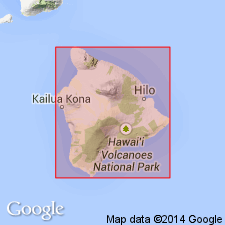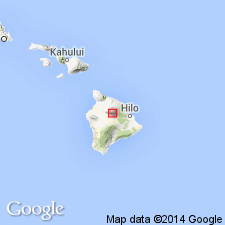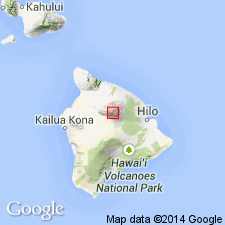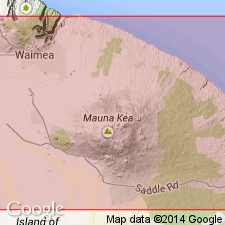
- Usage in publication:
-
- Hopukani Formation
- Modifications:
-
- First used
- AAPG geologic province:
-
- Hawaii
Summary:
Chart shows as older formation of Hamakua Group, Mauna Kea Volcano, Island of Hawaii. Exposed in stratigraphic section at upper end of Waikahalulu Gulch. Underlies Pohakuloa Formation, oldest exposed glacial drift on Mauna Kea Volcano. Assigned Pleistocene age.
Source: GNU records (USGS DDS-6; Menlo GNULEX).

- Usage in publication:
-
- Hopukani Formation
- Modifications:
-
- Geochronologic dating
- AAPG geologic province:
-
- Hawaii
Summary:
Lava flow sample of Hopukani Formation from lower Pohakuloa Gulch gives K-Ar age of 375,000 +/-50,000 yr B.P. In Waikahalulu Gulch sample from abraded flow of Hopukani Formation has K-Ar age of 270,000 +/-35,000 yr B.P.
Source: GNU records (USGS DDS-6; Menlo GNULEX).

- Usage in publication:
-
- Hopukani Formation
- Modifications:
-
- Named
- Geochronologic dating
- Reference
- Dominant lithology:
-
- Basalt
- AAPG geologic province:
-
- Hawaii
Summary:
Named after Hopukani Springs in upper Pohakuloa Gulch. Type section (of Hamakua Volcanic Series retained) on south wall of Laupahoehoe Stream gulch [19 deg 59' 49"N, 155 deg 14' 39"W, Papaaloa 7.5' quad], Mauna Kea Volcano, Island of Hawaii. Reference section in upper Pohakuloa Gulch and in upper Waikahalulu Gulch. Includes rocks formerly assigned by Stearns and Macdonald (1946) to upper member of Hamakua Volcanic Series. Consists of thin vesicular pahoehoe flows of alkalic olivine basalt. Is approx 25 m thick in Waikahalulu Gulch. Overlies lower member of Hamakua Group (of Stearns and Macdonald, 1946) along northeast coast of Mauna Kea. Interfingers with Pohakuloa Formation. Underlies Waikahalulu Formation of Laupahoehoe Group. K-Ar ages of 382,100 +/-60,000 to 278,500 +/-68,500 yr B.P. indicate Pleistocene age.
Source: GNU records (USGS DDS-6; Menlo GNULEX).

- Usage in publication:
-
- Hopukani Volcanic Member*
- Modifications:
-
- Revised
- AAPG geologic province:
-
- Hawaii
Summary:
Hopukani Formation reduced in rank from formation to member and renamed to indicate its lithology; unit now is Hopukani Volcanic Member of the Hamakua Volcanics (formerly Hamakua Group).
Source: GNU records (USGS DDS-6; Menlo GNULEX).

- Usage in publication:
-
- Hopukani Volcanic Member†
- Modifications:
-
- Abandoned
- AAPG geologic province:
-
- Hawaii
Summary:
Unit abandoned. Rocks reassigned to Hopukani Springs Volcanic Member (Hamakua Volcanics).
Source: GNU records (USGS DDS-6; Menlo GNULEX).
For more information, please contact Nancy Stamm, Geologic Names Committee Secretary.
Asterisk (*) indicates published by U.S. Geological Survey authors.
"No current usage" (†) implies that a name has been abandoned or has fallen into disuse. Former usage and, if known, replacement name given in parentheses ( ).
Slash (/) indicates name conflicts with nomenclatural guidelines (CSN, 1933; ACSN, 1961, 1970; NACSN, 1983, 2005, 2021). May be explained within brackets ([ ]).

